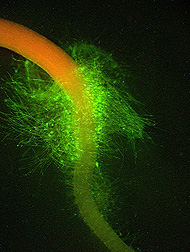|
Read the
magazine
story to find out more. |
|

Studies to understand how Listeria monocytogenes bacteria
colonize and spread on cabbage leaves could lead to new food safety practices.
|
|

ARS researchers are looking at varying abilities
of bacteria strains to grow on vegetables such as this broccoli sprout, where
green fluorescence indicates the presence of Listeria monocytogenesthree
days after innoculation in the lab. Photo courtesy of Lisa A.
Gorski.
|
|

|
Pathogen Genes Targeted in Studies to Protect
Salad Veggies
By Marcia Wood July
2, 2008
No one knows exactly how microbes like Listeria
monocytogenes or Salmonella enterica can attach themselves to the
bumpy leaves of a cabbage or the ultra-fine root hairs of a tender young
alfalfa sprout.
It's a mystery that Agricultural
Research Service (ARS) food safety scientists in Albany, Calif., are intent
on solving. The work, based at the ARS
Western
Regional Research Center, may lead to new ways to protect cabbage, sprouts
and other salad favorites from attack by foodborne pathogens.
Microbiologist
Lisa A.
Gorski, for instance, led an investigation several years ago that was the
first to document the genes that L. monocytogenes uses during a
successful invasion of cabbage leaves. Gorski did the work with Albany
colleague
Jeffrey
D. Palumbo and others.
Though scientists elsewhere had looked at genes that this Listeria
turns on--or "expresses"--when it's grown on a bed of gel-like agar in a
laboratory, no one had, at the time of Gorski's investigation, ever documented
genes that this microbe expresses when it grows on a vegetable.
Listeria is perhaps best known for establishing colonies in humans,
not on green plants. But the team found that Listeria, when invading cabbage,
calls into play some of the same genes that plant-dwelling microbes routinely
use to colonize and spread harmlessly on plants.
In newer work, Gorski wants to pinpoint genes responsible for the
widely varying ability of eight different Listeria strains to successfully
colonize the hair-thin strands, called root hairs, of alfalfa sprouts.
She's also interested in studying, and disabling, genes that help some
Listeria colonies resist being washed off by water.
Read
more about the research in the July 2008 issue of Agricultural Research
magazine.
ARS is a scientific research agency of the
U.S. Department of Agriculture.